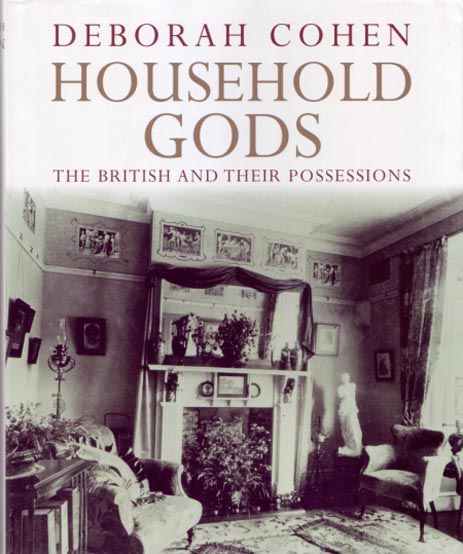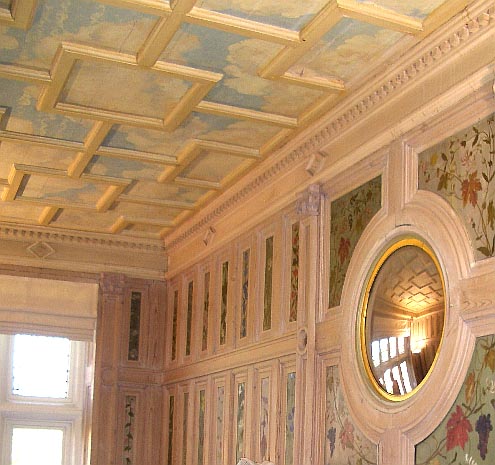 Deborah Cohen's Household Gods deals with home decoration and furnishing from the 1830s to the 1930s, so it not only covers the whole Victorian period, but puts it in context as well. In another way, too, its scope is large: like Judith Flanders' Consuming Passions (also published in 2006), it is part of the exciting new wave of sociological studies which go beyond the major figures of the day, showing the various other factors involved in what Cohen calls "middle-class self-fashioning" (xv). By relating matters of style and taste in the home to the larger trends in contemporary thought, and substantiating her findings from fresh sources like unpublished diaries, trade journals, household magazines and even stockbooks, Cohen has produced a hugely informative book which is also a delight to read. It is even a delight to look at, with just over 150 well-chosen contemporary illustrations, essential in a work on such a subject.
Deborah Cohen's Household Gods deals with home decoration and furnishing from the 1830s to the 1930s, so it not only covers the whole Victorian period, but puts it in context as well. In another way, too, its scope is large: like Judith Flanders' Consuming Passions (also published in 2006), it is part of the exciting new wave of sociological studies which go beyond the major figures of the day, showing the various other factors involved in what Cohen calls "middle-class self-fashioning" (xv). By relating matters of style and taste in the home to the larger trends in contemporary thought, and substantiating her findings from fresh sources like unpublished diaries, trade journals, household magazines and even stockbooks, Cohen has produced a hugely informative book which is also a delight to read. It is even a delight to look at, with just over 150 well-chosen contemporary illustrations, essential in a work on such a subject.
Cohen soon makes it clear that there was another "Battle of the Styles" in Victorian England besides that involving grand architectural projects. This one concerned the interiors of ordinary Victorian homes. Consider, for example, two contrasting residences described in Great Expectations (1861). Nothing could be more different from the warm-hearted Wemmick's Gothic wooden cottage in Walworth, its display of curiosities interspersed with "small specimens of china and glass" and bits of handiwork [compare illustration by Harry Furniss], than the stately but run-down Soho residence of his employer, the cold-hearted Mr Jaggers, where "there was nothing merely ornamental to be seen" (Chapter 26). We all know which side Dickens was on here. so this bears out Cohen's thesis in her first chapter, "Material Good," that by mid-century it was no longer considered sinful to abjure austerity. By now, in fact, "what one owned, bought and treasured helped to shape — and hence to communicate — something of the moral make-up of a person" (19). The only problem with my own example is the small matter of taste. The design reformer Henry Cole would probably have pitched the entire contents of Wemmick's house into the Chamber of Horrors which he created in his Museum of Ornamental Art after the Great Exhibition. So while it was agreed in the "broader, post-evangelical mindset" that "better rooms make better people" (28), who was to decide what made a better room?
Neither Cole himself nor, it seems, any of the other major arbiters of taste to whom we still pay homage. After "worshiping" in the vast furniture emporia which sprang up in London and the big cities, impressively illustrated in Chapter 2 ("Cathedrals to Commerce"), the newly affluent middle classes took away from them exactly what they fancied, helping to shape the market in the process. In 1881, however, people did find a voice to listen to attentively: "There is no ought in beauty, save your own feeling of delight" (qtd. in Cohen 62) was the encouraging pronouncement of Mary Eliza Haweis, the author of several books about home decoration. Cohen's next two chapters, Chapters 3 ("Art at Home") and 4 ("In Possession"), show how the house now came to be seen as a showcase for the artistic sensibility, requiring composition, sensitivity and originality. As if on cue, women enter the home-decorating picture around this time. Up until now, we learn, it had been a predominantly male province (so even in this, Wemmick was typical), and in making their homes beautiful this new generation of women were also trying to "make" themselves:
Against the backdrop of parliamentary crusades, the right to make a home became a feminist rallying cry. This was a new domesticity, a more militant domesticity, which points up the degree to which Victorian women's rights within the home were neither as secure nor as extensive as has been assumed.... In The Duties of Women, Frances Power Cobbe asserted that the home, famously women's sphere, was also her prerogative. Cobbe, exiled from her girlhood Irish home by the common law governing property, staked a woman's claim to homemaking: "The making of a true home is really our peculiar and inalienable right, — a right which no man can take from us; for a man can no more make a home than a drone can make a hive.... It is a woman, and only a woman, — and a woman all by herself, if she likes, and without a man to help her — who can turn a house into a home." [105]
This is a good example of how skilfully Cohen relates her subject to the wider issues of the day, and of how, in doing so, she overturns some common assumptions (for hadn't we thought, most of us, that women always chose the carpets?).

Burges's Flower Room at Milton Court estate near Dorking in Surrey.
What a truly artistic woman could achieve in this area is amply illustrated at Milton Court in Surrey, where William Burges helped the wealthy Mrs Rate to create the house of her dreams: her 1870s boudoir, with its panelled sky ceiling and delicate hand-painted flower walls is bright, light and restful. But few had such mentors or talents. Cohen has already made it clear that "men such as John Ruskin and William Morris are only the best known, not necessarily the most influential, of art's advocates" (64), and that, far from promoting the drive towards home decoration, the aesthetes almost scuppered it by giving the "search for beauty" a bad name (79). So in Chapter 5 ("Home as a Stage"), we find that as the movement towards bold self-expression went into full swing, rooms began to take on what we now think of as a characteristically Victorian cluttered look, with stuffed animals, exotic wares and so on in every alcove: "Artistic advisers such as Mrs Haweis, in emphasising the joys of self-expression in the place of design reform's strictures, had anticipated the personality. However, they could not have predicted the feverish quest for individuality, defined as the leitmotif of personality, which would ensue" (125).
A part of all this was the fad for antiques, which Cohen deals with next (Chapter 6 is entitled "Designs on the Past"). This goes back to the mid-1860s when old china first became sought after, but only really caught on towards the turn of the century. Finally and rather sadly, Chapter 7 ("Modern Living") begins to chart the evolution of a more generally agreed "decorative orthodoxy" (189). This is what has produced the bland modern homes of today, painted and carpeted in "neutral tones throughout," as British estate agents are fond of saying as a recommendation to prospective buyers, and furnished almost identically. While this began partly as a revulsion against the excesses of Victorian "quaintness," many other factors have become involved along the way, including the phasing out of true craftsmen, the impact of two sobering world wars, the downsizing of our rooms, and perhaps above all the stream of style gurus who now come right into our homes via television makeover programmes. Surely Victorians like William Morris, William Burges and Lord Leighton, who lavished attention on every detail of their living space, filling it with colour and fine workmanship of all kinds, would have been dismayed by this triumph of "good taste."
Household Gods itself is a treasure-trove. I looked in vain for a List of Illustrations, and I would like to have learnt more about those major figures, in what I now see is their fuller context (Leighton only gets one passing mention, for example, although Cohen herself notes that his Kensington home gave us the word "leightonesque" as an adjective for interior design). But since such figures are already well served by other scholars, and since there is so much illuminating new material here, woven together so satisfyingly, too, it seems very ungrateful to ask for more.
Related Materials
Bibliography
Cohen, Deborah. Household Gods: The British and Their Possessions. New Haven and London: Yale University Press, 2006. 296 + xvii pp. £25.00 ISBN 0-300-11213-0
Created 23 November 2006
Last modified 5 March 2023